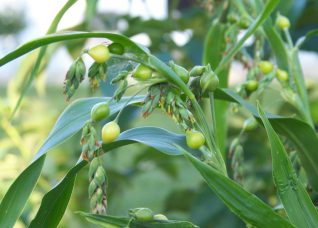
MinerAlert

MinerAlert
Coix lachryma-jobi
Poaceae
Yi yi ren, Coix seeds, Adlay, Adlay millet, Gavedhukaa, Kaatu- Kunthumani, Gadagad, Kesai

The fruits (“seeds”), leaves, and root
The leaves, root, and seed can be decocted and taken as a tea or used externally as an antiseptic wash. The seed is edible and has nutritional value (Khare, 2016).
This member of the grass family is native to Southeast Asia and has been used for centuries in Traditional Chinese Medicine (TCM), as well as Ayurvedic medicine of India, as a nutritious foodstuff and mild sedative, as well as for the treatment of a plethora of health conditions including: diabetes, rheumatism, menorrhagia, diarrhea, warts, urinary problems, puerperal fever, chronic enteritis, intestinal parasites, various types of cancer (especially lung and intestinal), tuberculosis, musculo-skeletal pain, swelling, and endocrine dysfunctions. A decoction for the seed is also used to bathe newborns to prevent disease (Khare, 2016; Quattrocchi, 2012; Tang and Eisenbrand, 2011; Hempen and Fischer, 2007; Ghani, 2003; Huang, 1999; Duke and Ayensu, 1985).
In the three main medical systems of India (Ayurveda, Siddha, and Unani-Tibb), the leaves are decocted and taken as a tea for the treatment of diabetes and rheumatism. The root is also decocted for the treatment of dysentery, intestinal parasites, gonorrhea and menstrual problems (Quattrocchi, 2012).
In India, a tea made from the leaves is used to induce fertility in women. The seeds contain active compounds that are used to stimulate ovulation, and the seed extract possess anticancer properties (Khare, 2007; 2016).
A study on the tropical island of Mauritius was designed to record, document, and assess animal as well as herbal-based therapies used for the treatment and management of pain. The data was obtained from traditional medicine users as well as practitioners by means of via face-to-face interviews. The results showed that Job’s tears was one of the plants most used for the treatment of lower back pain (Sreekeesoon and Mahomoodally, 2014).
Hepatocellular carcinoma (HCC) is the fifth most prevalent malignant tumor in men worldwide and the second most frequent cause of cancer related mortality. Kanglaite® (KLT) is an injectable proprietary lipid substance extracted from the seeds of the graminaceous plant commonly known in China as Yi yi ren (Coix lacryma-jobi or “Job’s tears”). There is certain evidence that the medical use of the seed and its extracts has a beneficial effect for the treatment of cancer metastasis, as well as other disorders including hypertension, arthritis, asthma, and immunological problems. The present study also demonstrated that KLT significantly inhibited tumor growth in mice transplanted with HepG2 cells. For this reason, the authors of the study proposed that treat-ment with KLT may enhance the immune system of patients affected with HCC (Huang et al., 2014).
Certain products containing some of the bioactive ingredients in Job’s tears are currently used therapeutically to combat cancer. A proprietary product known as Kanglaite® (KLT), is an injectable preparation widely used for cancer treatment in China. KLT possesses an inhibitory effect on various types of tumors. It is also known that the signaling pathway, known as PI3K/Akt/mTor, encourages cell survival, proliferation, and progression in cancerous cells. For this reason, Liu et al. (2014) studied the effects of KLT on the PI3K/Akt/mTOR pathway in pancreatic cancer xenografts in mice, and evaluated its potential as a therapeutic agent against cancer. The results of the study suggested that KLT can suppress growth and induce apoptosis (programmed cell- death) of pancreatic cancer xenografts. Additionally, KLT can downregulate the expression of phospho-Akt and phospho-mTOR to modulate the PI3K/Akt/mTOR signaling pathway. The authors suggest that targeting this pathway may lead to the development of novel therapeutic options for various human cancers.
Safety/Precautions:
Before you decide to take any medicinal herb or herbal supplement, be sure to consult with your health care professional first. Avoid self-diagnosis and self-medication: Always be on the safe side!
Duke J, Ayensu E. Medicinal Plants of China 2 vols.
Algonac, MI: Reference Publications:1985; p. 488.
Ghani A. Medicinal Plants of Bangladesh; Chemical Constituents and Uses 2nd ed.
Dhaka, Bangladesh: Asiatic Society of Bangladesh; 2003; pp. 179-180.
Hempen C, Fischer T. A Materia Medica for Chinese Medicine.
London: Churchill Livingstone; 2011; pp. 308-309.
Huang X, Qin J, Lu S. Kanglaite stimulates anticancer immune responses and inhibits HepG2 cell transplantation‑induced tumor growth. Mol Med Rep. 2014; 10(4):2153-9. doi: 10.3892/mmr.2014.2479.
Huang K. The Pharmacology of Chinese Herbs 2nd ed.
Boca Raton, FL: CRC Press; 1999; p. 480.
Khare C P. Ayurvedic Pharmacopeial Plant Drugs.
Boca Raton, FL: CRC Press; 2016; pp.186-187.
Khare C P. Indian Medicinal Plants: An Illustrated Dictionary.
New Delhi, India: Springer-Verlag; 2007; p. 165.
Liu Y, Zhang W, Wang XJ, Liu S. Antitumor effect of Kanglaite® injection in human pancreatic cancer xenografts. BMC Complement Altern Med. 2014 ;14:228. doi: 10.1186/1472-6882-14-228.
Quattrocchi, U. World Dictionary of Medicinal and Poisonous Plants (4 vols.).
Boca Raton, FL: CRC Press; 2012; pp. 352-353.
Sreekeesoon DP, Mahomoodally MF. Ethnopharmacological analysis of medicinal plants and animals used in the treatment and management of pain in Mauritius.
J Ethnopharmacol. 2014 ;157:181-200. doi: 10.1016/j.jep.2014.09.030.
Tang W, Eisenbrand G. Handbook of Chinese Medicinal Plants 2 vols.
New York: Wiley; 2011; pp. 380-383.